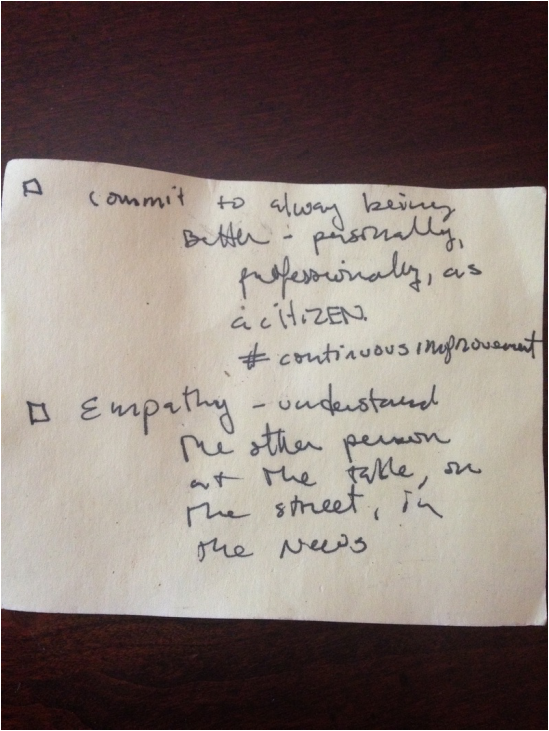|
I recently helped Cambridge Community Services define it's vision. As part of the exercise, the Board did a full-day offsite. To kick-off the offsite, the meeting leader asked us to think for a few minutes and then write down our individual core values.
I'm a huge proponent of core values. At Teach For America, I saw core values guide decisions and settle debates. At TalkTo, core values of exceptional service, team, integrity and improvement are the fabric of our work. Core values, simply put, are guideposts for any challenge and every opportunity. Despite my deep appreciation for shared values within organizations, I never thought about my own personal core values. Thus, I found this exercise very helpful. Below is the notecard that I penned in 5 minutes; but the words will last a lifetime. Grab a pen, a piece of paper and write down your Core Values. And next time you are working with someone and they are struggling with a decision, ask them "What are you core values?" The answer to that question will guide the decision.
2 Comments
I was cleaning out emails and found this email from May 2013. It was sent to my Team Leads at TalkTo. #TurningEmailsIntoBlogPosts. COACHING is not easy. Think about it: You have a goal (e.g. improved attendance) or a piece of knowledge (e.g. the best way to talk to a business) in your mind and your job is to explain that goal/knowledge to someone and then have them do it as well as you expect. Not easy! But coaching is a key part of all of our jobs.
So what's the best way to coach? Here's my thinking. Timing and setting matters. Some people are OK with "intervention" coaching, meaning right at the point of the problem. Others might be edgy or defensive at that moment and prefer "post mortem" coaching. Your job is to know what works best for each of your team members and try to adjust. If the situation doesn't allow you to act exactly as the team member wants, that's OK. Just be cognizant of the team member's preference. If, for example, you need to intervene on a person that prefers post mortem, lead with something like, "I apologize for intervening right now. But I'm hoping to quickly speak with you about XYX. Sound good?" Of course, the best is a routine coaching session that is scheduled and planned. I know you're doing this; please keep it up. This will be extremely important for new hires. Shoot for 1 session each week for the first month. After the first month, you'll have a better understanding of what is necessary. As always, test and learn. Also, setting matters. Some people prefer chat; it allows them to slowdown and think through their response. Other's have trouble picking up subtleties in chat and do better of the phone. Lead with something positive. We all appreciate being recognized for our good work. Whenever possible, lead with a positive accomplishment. For example, after two weeks of near perfect attendance one of your team members arrives 30 mins late. Given the history of this teammate, you want to coach in order to avoid sliding back into a negative trend. Lead with, "Thank you for your improved attendance over the last two weeks. It's made a noticeable difference in your work and its had an impact on the entire team. Let's keep this trend going, which is why I want to speak with you about yesterday's tardiness." Paint a big picture with Us and We; avoid I/You. The I/you structure is polarizing. It puts people on the defensive and it won't make for a constructive coaching session. Rather, elevate coaching to the greater group. Let's again use the team member who is late. "You were late yesterday. I want to you improve your attendance" is confrontational. Rather, elevate the issue to the greater group. "Being on time is extremely important. Arriving on-time positively impacts every aspect of our business. Our users benefit from faster service. Our team members aren't stretched thin and are able to take an adequate amount of breaks. This is why it is so important for all us to be on time." Note that I focused on the positive ("being on time") and not the negative ("being late"). Leave the coaching session with an action plan/goal If you layout a plan or set a goal, you'll have a meaningful point of reference for the next coaching session. So leave a meeting with an explicit goal or plan and then review the progress of that plan or goal in the next meeting. In 2006, I started a biodiesel operation for The Doe Fund, a non-profit organization in NYC that creates businesses to employ formerly homeless or incarcerated men. There I was: a kid from rural Massachusetts leading 10 men from the toughest neighborhoods in New York. One of my employees, who was about my age, hailed from the South Bronx but had spent the last 10 years in Federal Prison for shooting a rival dealer. Another had started using heroin when he was nine years old.
Today, my team at Spottah is the exact opposite: highly skilled knowledge workers. The degree-to-employee ratio is 1.7. Technology recruiters, not DEA agents, are breaking down our doors. Email is our addiction. These distinct experiences defined my management philosophy. The manager’s job is to understand the goals of his team members, and align those goals with the organization’s goals. The fact that this philosophy works with people three sigmas right or left is testament to its strength. Take Lester from The Doe Fund, for example. Lester’s goal was to land a job with New York City Sanitation. Some of you may be thinking, “‘garbage man’ doesn’t sound like a great goal.” But it is. It’s high-paying, secure, and provides benefits. Once I knew Lester’s goal, I was able to align his goal with the goal of my biodiesel unit. We focused on establishing a safe driving record, following safety protocols, truck maintenance and crew management. Fast forward to Spottah. A few months back, we brought on a new graphic designer named Chris. Chris came to us as a product manager at a major web property. The extent of his design experience were a few side projects and a ton of photography. He knew photoshop and had an eye for design. Being a product manager, Chris had two personal goals. First, improve as a designer, specifically by focusing on logos & icons, textures, fonts and the balance of the screen. Second, he wanted to push the boundaries of the mobile user experience. Initially, I favored an incremental redesign -- you know, change an image size here and a font there and eventually achieve a new look. Incremental change, however, did not align with Chris’s goals. Furthermore, incremental change was not best for Spottah; our success rests on an amazing user experience. So we tasked Chris with razing the old design and completely re-imagining our product. Thanks to Chris’s designs and Yin’s ability to implement anything, the new version of Spottah looks and feels amazing. Here is a taste, but you’ll have to wait a bit longer for the full meal. Sorry. Gaining an honest understanding of your team members’ goals is not easy. A person’s goals may not include the current company; Lester, for example, had a goal of working for DSNY, not The Doe Fund. Also, a person may fear that their goal counters the goal of their manager or another team member; Chris wanted a complete redesign while I initially wanted to move in increments. It is essential to create an environment where people can honestly share their goals. If a company fails to achieve this, than people will project false goals and the manager will not be able to develop a meaningful plan for achieving individual and company goals. |
JONATHAN STEIMAN
I'm the Founder and CEO of Peak Support. This blog is my take on early-stage companies and innovation. Every so often, there may be a post about culture, networking, family -- you name it. After all, what is a blog if it isn't a tad bit unstructured.
Archives
December 2016
Categories
All
|


